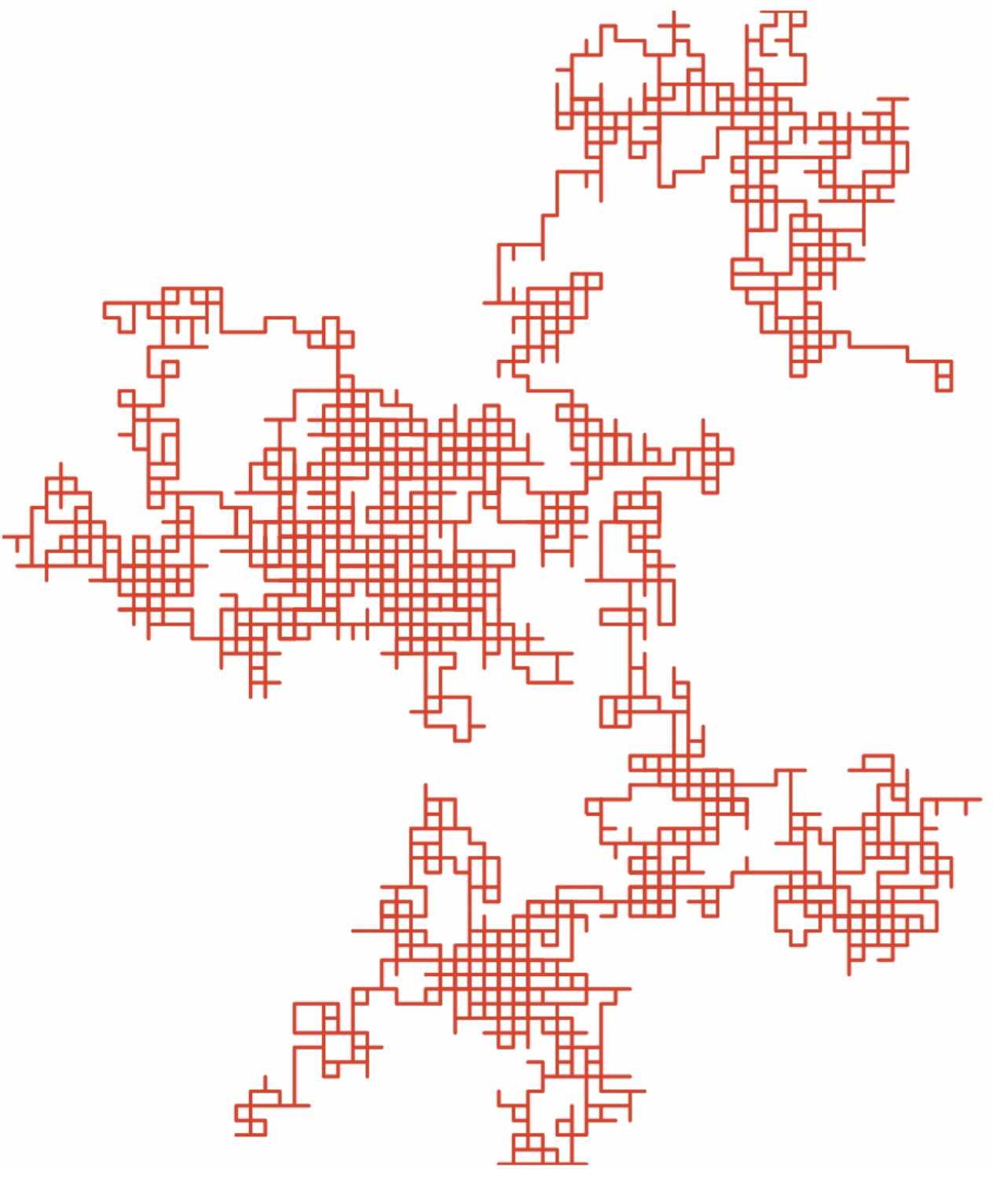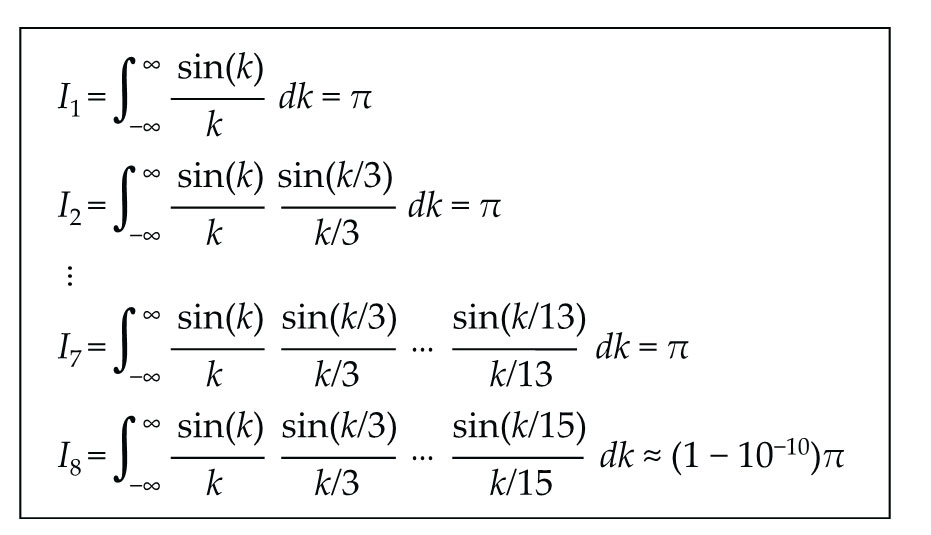Random walkers illuminate a math problem
DOI: 10.1063/PT.3.4287
In a 1905 issue of Nature, statistician Karl Pearson of University College London asked readers for their help with a problem he named the random walk 1 : A walker starts at an origin point and walks l yards in a straight line in a random direction. The walker then turns and proceeds another l yards in another random direction, and the process repeats n times. Having found the solution only for the case of two steps, Pearson wanted an expression for the probability that the walker is a radius r from the starting point after n steps.
In the intervening 114 years, the random walk—or, more colorfully, the drunkard’s walk—has been applied to such diverse fields as ecology, economics, computer science, biology, chemistry, and physics, and it helped produce the art on the cover of this issue. Physicists use the random walk to model diffusion, Brownian motion, polymers, and even quantum field theory. Random walkers can move in one, two, or more dimensions, and their steps can have a fixed length or a probabilistic distribution of possible lengths. Figure
Figure 1.

The path of a two-dimensional random walk is generated when a simulated walker probabilistically takes horizontal or vertical steps of a fixed length.

Random walks can now add solving integrals to their resume because of the work of Satya Majumdar and Emmanuel Trizac of Université Paris–Sud/CNRS.
2
The project started one Sunday in May 2018 when a Twitter post captured their attention. The tweet, from Fermat’s Library (@fermatslibrary
Integral to our understanding
The integrals In in question are shown in figure
Figure 2.

Borwein integrals integrate over products of factors of the form sin(anx)/anx. One variant, with an = 1/(2n − 1), is shown here. The first seven integrals, I1 to I7, all equal π. Beginning at I8, all of the subsequent integrals are slightly, and increasingly, less than π.

The Borweins found an expression for the first integral that deviates from the pattern in all Borwein integrals. If the first coefficient a1 is larger than the sum a2 + … + aj of all the rest of the coefficients, the integral gives the expected value. In I3, for example, the coefficients are 1, ⅓, and ⅕; 1 > ⅓ + ⅕, and the integral is π, as expected. Once the sum exceeds the first coefficient, the value of the integral changes. For the integrals in figure
Inspired by the tweet, Majumdar and Trizac hoped a physics perspective might offer some insight to the problem, and they began searching for a relevant reformulation. The pattern breaking reminded the pair of a phase change, but the resemblance proved fruitless. It was then that the structure of the integral reminded them of a Fourier transform. With that insight, the connection to random walkers became obvious.
Walk the line
Majumdar and Trizac restricted their imagined random walkers to a 1D walk with the ability to share the same position. They started with an infinite number of random walkers spread out evenly along an infinitely long line. When all the walkers take random steps, the number of walkers that leave a position—call it position x = 0—is the same as the number of walkers that land on that same position. No matter how many steps the random walkers take, the total number at x = 0 stays the same.
But what if the random walkers occupy a finite space? If they start from x = 0 and take an initial step with a size equally distributed in the range |Δx| ≤ 1, the walkers will be evenly spread from −1 to 1 (see the left panel of figure
Figure 3.

The distribution of random walkers evolves as they take steps dictated by the integrals in figure 2. After their first step, the walkers are evenly distributed between −1 and 1 (left panel). After a step of length from −⅓ to ⅓, some walkers spread out beyond ±1 on the number line (middle panel). After another step of up to ±⅕, the walkers spread out even more (right panel). In all three, the normalized distribution at x = 0 remains ½. (Adapted from ref.

The second integral calculates the fraction of walkers at x = 0 after they each take a second step with |Δx| ≤ ⅓. Another step with |Δx| ≤ ⅕ produces the situation in the third integral, and so on. With each step, the random walkers spread out more (see the middle and right panels of figure
Their intuitive picture does more than reveal when the results of the integrals change; it also offers a way to avoid directly calculating those complicated integrals. One simply finds the normalized density of random walkers at x = 0. The density after the first step—and the next six steps—is ½, which needs to be multiplied by a factor of 2π to get the value of the first seven integrals. That calculation-free route to the solution will be important for other integrals that haven’t been or can’t easily be numerically solved.
All in the family
The method from Majumdar and Trizac applies to all variants of Borwein and many similar integrals. One such family of integrals takes the form of those in figure
The same logic can be applied for families of integrals in which the walkers start evenly distributed in a finite range or all the walkers start at two points ±b, as defined by a coefficient b in a cosine or Bessel function. The walkers can take steps with a range of sizes, as defined by the coefficients an in sin(anx)/anx factors, or any other distribution of steps as long as they are bounded. And if no longer confined to 1D, random walkers can be applied to integrals in any number of dimensions. “We have put forward a tool that hopefully will prove useful for computing even more complex quantities,” says Trizac.
In addition to their purely mathematical interest, sin(ax)/ax functions and integrals of those functions appear frequently, perhaps unsurprisingly, in Fourier analysis—for example, the sin(ax)/ax function is used to smooth Fourier series. Fields such as acoustics and optics rely heavily on Fourier analysis for signal processing. But the connection with random walkers may open up new avenues for applications.
References
1. K. Pearson, Nature 72, 294 (1905). https://doi.org/10.1038/072294b0
2. S. N. Majumdar, E. Trizac, Phys. Rev. Lett. 123, 020201 (2019). https://doi.org/10.1103/PhysRevLett.123.020201
3. D. Borwein, J. M. Borwein, Ramanujan J. 5, 73 (2001). https://doi.org/10.1023/A:1011497229317
